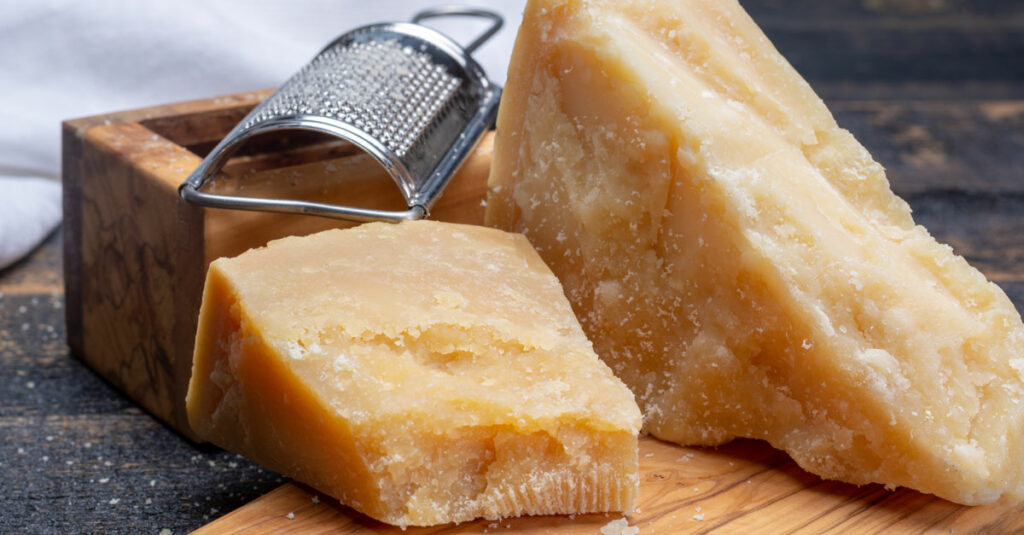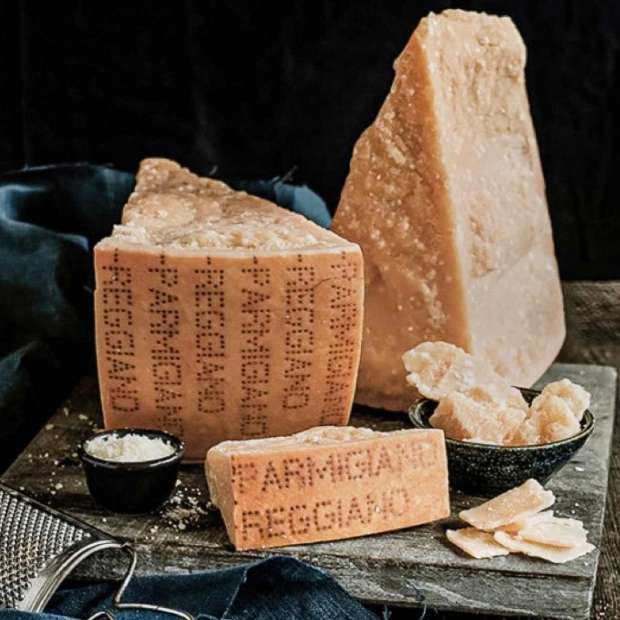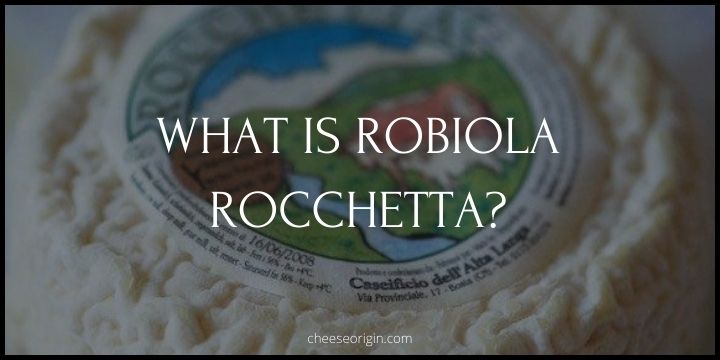What is Parmigiano-Reggiano? Italy’s Cheese Crown Jewel

Welcome to the world of cheese, where one name reigns supreme – Parmigiano Reggiano. Often referred to as the ‘King of Cheeses’, this Italian marvel is a culinary crown jewel that has been delighting palates for centuries.
But what makes Parmigiano Reggiano so special? What sets it apart from the myriad of other cheeses vying for our attention? Join us as we embark on an epicurean journey to the heart of Italy, exploring the history, the artistry, and the sheer gastronomic pleasure that this magnificent cheese brings to the table.
Prepare to dive into the rich, nutty, and complex universe of Parmigiano Reggiano, a cheese that is not just food, but a testament to a tradition that has stood the test of time.
Quick Facts About Parmigiano-Reggiano
| Fact Category | Details |
|---|---|
| Origin | Italy, specifically the regions of Parma, Reggio Emilia, Modena, and parts of Bologna and Mantova. |
| Protected Designation | Protected Designation of Origin (PDO) since 1992 by European Union law. |
| Ageing Process | A minimum of 12 months, with three classifications based on age: “Mezzano” (18-20 months), “Vecchio” (over 2 years), and “Stravecchio” (over 3 years). |
| Texture | Hard, granular, and crystalline, with a natural rind. |
| Taste | Nutty, sweet, and tangy with notes of fruit and nuts. |
| Color | Straw-yellow. |
| Production | Made from raw cow’s milk, partially skimmed through a natural creaming process. |
| Uses | Can be eaten alone, grated over pasta, used in soups, salads, or risottos, and paired with honey, balsamic vinegar, or fruits. |
| Nutritional Value | High in protein, vitamins, and minerals like calcium and phosphorus. Low in fat and lactose. |
| Shelf Life | Can last up to 1 year if stored properly. |
What is Parmigiano-Reggiano?

Parmigiano-Reggiano, often known colloquially as “Parmesan,” is a hard, granular cheese that originates from Italy. This iconic cheese is named after the provinces of Parma and Reggio Emilia, where it is produced under strict regulations. However, its production also extends to parts of the provinces of Modena, Bologna, and Mantova.
Parmigiano-Reggiano carries a Protected Designation of Origin (PDO) status, which means it must adhere to specific production standards set by the European Union since 1992. This ensures that every wheel of Parmigiano-Reggiano maintains the quality and characteristics that have made it famous worldwide.
The cheese is made from raw cow’s milk that has been partially skimmed through a natural creaming process. After the curdling process, the cheese is pressed into wheels and aged for a minimum of 12 months. However, premium versions of Parmigiano-Reggiano are often aged for over two years (“Vecchio”) or even over three years (“Stravecchio”).
The result is a cheese with a hard, crystalline texture and a rich, complex flavor that is both sweet and savory. The taste often carries notes of nuts and fruits, making it a versatile addition to many dishes. It can be eaten alone, grated over pasta, used in soups, risottos, or salads, and paired with honey, balsamic vinegar, or fruits.
Nutritionally, Parmigiano-Reggiano is a powerhouse. It is high in protein and packed with essential vitamins and minerals like calcium and phosphorus. Additionally, it is low in fat and lactose, making it a healthier cheese option for many individuals.
What Does Parmigiano-Reggiano Taste Like?
Parmigiano-Reggiano has a complex, sophisticated flavor that is hard to replicate. It’s known for its rich, savory, and nutty taste that is full of umami, the so-called fifth taste that signifies savoriness.
The initial flavor when you take a bite is a sweet and creamy sensation, quickly followed by more complex notes. The nuttiness is akin to fresh almonds or cashews, while there’s also a fruity undertone reminiscent of pineapple or citrus. As the cheese matures, it develops a stronger, richer taste with hints of spice and a slightly grainy texture due to the crystallization of proteins and amino acids.
The rind of Parmigiano-Reggiano, which is also edible, has a harder texture and a deeply savory flavor. It’s often used in soups or stews to add an extra layer of complexity to the dish.
Overall, the taste of Parmigiano-Reggiano is robust, full-bodied, and long-lasting on the palate, making it a cherished addition to a variety of dishes or a flavorful snack on its own.
Parmigiano-Reggiano Tasting Notes

- Appearance: Parmigiano-Reggiano has a hard, straw-yellow interior with a natural, golden-brown rind. The cheese is granular and often features white crystals, especially in older varieties.
- Texture: It has a hard, dense texture that can be slightly crumbly, yet it melts smoothly in the mouth. The presence of crunchy protein crystals increases with age, giving an enjoyable contrast to the otherwise smooth body of the cheese.
- Aroma: This cheese emits a rich, savory aroma that can be described as nutty and fruity. There may also be hints of grass or hay, reflecting the diet of the cows whose milk is used in production.
- Flavor: Initially, the flavor is creamy and sweet, but this quickly develops into more complex, savory notes. The taste is rich and umami-packed, with hints of nuts, butter, and fruit. As the cheese ages, it becomes more intense, with a slightly spicy undercurrent.
- Aftertaste: The aftertaste of Parmigiano-Reggiano is long-lasting and complex, leaving a lingering savoriness on the palate. Some people also note a slight bitterness in the finish, similar to that of a well-aged wine.
- Pairings: Parmigiano-Reggiano pairs well with a variety of foods and wines. Try it with full-bodied red wines, fresh fruits like apples and pears, or drizzled with honey or a drop of balsamic vinegar. It also shines when grated over pasta, risotto, or used in soups and salads.
What’s the difference between Parmesan and Parmigiano Reggiano?
Parmesan and Parmigiano-Reggiano are often used interchangeably, but there are some key differences between these two types of cheese.
| Aspect | Parmesan | Parmigiano-Reggiano |
|---|---|---|
| Origin | Generic term used worldwide. Can be made anywhere. | Protected Designation of Origin (PDO) in Italy. Made in specific regions: Parma, Reggio Emilia, Modena, and parts of Bologna and Mantova. |
| Production Standards | No strict production standards. According to the US Code of Federal Regulations, it’s a cow’s milk cheese with a “granular texture” and a “hard and brittle” rind. | Strict production standards under Italian law and PDO status. Made from partially skimmed, unpasteurized cow’s milk from grass-fed cows. |
| Aging Process | Often aged for a shorter period, sometimes only ten months. | Aged for at least 12 months, with many premium versions aged for over two years or more. |
| Texture | Can vary, generally hard and granular. | Hard and slightly crumbly, with visible crystals in aged varieties. |
| Flavor | Milder flavor, may not offer the same depth and complexity. | Rich, complex flavor with a robust, umami-packed taste, and hints of nuts, butter, and fruit. Flavor intensifies with age. |
| Cost | Generally less expensive. | More expensive due to the lengthy aging process and strict production standards. |
Firstly, “Parmigiano-Reggiano” is a protected term under Italian law and the European Union’s Protected Designation of Origin (PDO) status. This means that only cheese produced in specific regions of Italy (Parma, Reggio Emilia, Modena, and parts of Bologna and Mantova) and under strict guidelines can be called “Parmigiano-Reggiano”.
On the other hand, “Parmesan” is a generic term in many countries, including the U.S., and does not have to adhere to the same strict production standards. It can be made anywhere and does not necessarily have to follow the traditional Italian method. According to the US Code of Federal Regulations, anything called “parmesan” must be a cow’s milk cheese with a “granular texture” and a “hard and brittle” rind.
In terms of aging, Parmigiano-Reggiano is aged for a minimum of 12 months, with many premium versions aged for over two years or more. In contrast, Parmesan cheese found in the United States is often aged for a shorter period, sometimes only ten months.
The flavor and quality also differ. Parmigiano-Reggiano has a rich, complex flavor and a slightly crumbly texture. The taste is robust and umami-packed, with hints of nuts, butter, and fruit. As the cheese ages, it becomes more intense and develops a slightly spicy undertone. Conversely, Parmesan cheese tends to have a milder flavor and may not offer the same depth and complexity.
While Parmigiano-Reggiano and Parmesan might seem similar, they are distinct in their production, aging process, and flavor profile. Parmigiano-Reggiano is a testament to centuries-old Italian traditions and stringent craftsmanship, while Parmesan is a more accessible and versatile cheese that can be produced globally.
>> Click here to read our in-depth guide on Parmesan
What is so Special About Parmigiano Reggiano?
Parmigiano Reggiano, often referred to as the “King of Cheeses,” is special for these 7 reasons:
- Protected Designation of Origin (PDO): Parmigiano Reggiano holds a Protected Designation of Origin (PDO) status. This means it can only be produced in specific regions of Italy: Parma, Reggio Emilia, Modena, and certain parts of Bologna and Mantova.
- Natural and Nutritious: It is 100% natural with no additives or preservatives and is lactose-free1. It is rich in protein, calcium, and other essential nutrients.
- Traditional Craftsmanship: The production process of Parmigiano Reggiano is an age-old tradition that has been passed down through generations. Each wheel of cheese is crafted carefully using traditional methods.
- Unique Flavor and Texture: Parmigiano Reggiano is known for its complex flavor profile and slightly crumbly texture. It has a robust, umami-packed taste, with hints of nuts, butter, and fruit.
- Aging Process: It is aged for a minimum of 12 months, and many premium versions are aged for over two years, which intensifies its flavor.
- Versatility: While it’s often thought of as a grating cheese in the States, connoisseurs around the world appreciate Parmigiano Reggiano as a standalone table cheese as well.
- Quality Control: Each wheel of Parmigiano Reggiano is inspected to ensure it meets the highest standards of quality.
Important tip: while Parmigiano Reggiano is indeed a special and high-quality cheese, it does have a relatively short shelf life once opened. Therefore, it’s best to purchase in smaller quantities and consume within a reasonable time to enjoy its optimal flavor.
Why is Parmigiano Reggiano so Expensive?

- Protected Designation of Origin (PDO): Parmigiano Reggiano is produced only in certain regions of Italy under strict regulations. This exclusivity contributes to its higher price.
- High Production Costs: A large amount of milk is required to produce a single wheel of Parmigiano Reggiano. It takes about 16 liters of milk to make one kilogram of cheese. Moreover, the cheese-making process is labor-intensive, requiring skilled cheesemakers and rigorous quality checks.
- Aging Process: The cheese is aged for a minimum of 12 months, and some are aged for over two years or more. This lengthy aging process requires storage space and care, which adds to the cost.
- Quality and Flavor: The unique, complex flavor and high quality of Parmigiano Reggiano also contribute to its price. Its rich, umami-packed taste and slightly crumbly texture are highly valued by consumers and chefs alike.
- Transportation and Import Costs: For consumers outside of Italy, import taxes and transportation costs can also add to the price of Parmigiano Reggiano.
How Much Does a Wheel of Parmigiano Reggiano Cost?
| Retailer | Size (lbs) | Price (USD) |
|---|---|---|
| Amazon | 86 | $1,299.00 + $84.10 shipping |
| Alma Gourmet | 80 | $1,450.00 |
| Gourmet Food Store | 90 | $2,052.90 |
| Gourmet Italian | 20 (1/8 wheel) | $315 (at $15.75 per lb) |
Can You Eat Parmigiano Reggiano Straight?
Yes, you can certainly eat Parmigiano Reggiano straight. In fact, it’s a common way to enjoy this delicious and flavorful cheese. Many people enjoy it on its own or paired with fruits like pears and grapes, or with a drizzle of honey. It’s also often served with wine as part of a cheese platter.
However, Parmigiano Reggiano is also commonly grated over pasta, risottos, and soups; shaved onto salads or carpaccio; or cooked into a wide variety of dishes. Its rich, nutty flavor enhances many recipes.
Remember, the rind of the cheese is also edible and is often used to flavor soups and stews. Just remove it before serving the dish.
What is Parmigiano Reggiano Best Used For?

- Grating Over Pasta and Risotto: Its robust flavor enhances the taste of pasta and risotto dishes. It’s often used in traditional Italian recipes like Spaghetti Carbonara or Fettuccine Alfredo.
- Shaving onto Salads: Thin shavings of Parmigiano Reggiano can add a burst of flavor to salads. It pairs especially well with arugula, spinach, and Caesar salads.
- Serving on a Cheese Board: Parmigiano Reggiano can be enjoyed straight, often as part of a cheese platter. It pairs well with fruits like pears and figs, nuts, honey, and a variety of wines.
- Cooking in Soups and Stews: The rind of Parmigiano Reggiano is packed with flavor. Many chefs add it to soups and stews during cooking, then remove it before serving.
- Baking into Dishes: Parmigiano Reggiano can be baked into a variety of dishes, including quiches, frittatas, and gratins. Its flavor becomes even more intense when melted.
- Enhancing Meat and Fish Dishes: Parmigiano Reggiano can be used in the breading for chicken cutlets or fish fillets, or mixed into meatballs or meatloaf.
- Making Parmesan Crisps: When baked or fried, Parmigiano Reggiano turns into a delicious, crispy snack.
- Sprinkling on Popcorn: For a gourmet twist on a classic snack, try sprinkling grated Parmigiano Reggiano over freshly popped popcorn.
Is Parmigiano Reggiano a Healthy Cheese?
Yes, Parmigiano Reggiano is a healthy cheese. Here’s why:
- High in Nutrients: Parmigiano Reggiano is rich in vitamin B12, calcium, and zinc. These nutrients are preserved due to the meticulous way the cheese is made
- Good Source of Protein: It provides 10 grams of protein in a one-ounce serving, which contributes to muscle growth and repair
- Easily Digestible: The cheese is easily digestible due to the presence of ready-to-use proteins and lipids. It’s also lactose-free, which makes it suitable for people with lactose intolerance
- Bone Health: Parmigiano Reggiano is a good source of calcium, which is essential for healthy and strong bones
- Low in Fat and Carbs: The cheese is naturally low in fat and carbs, making it a good option for those following certain dietary plans
Note: while Parmigiano Reggiano has many health benefits, it’s also high in calories. As with any food, it’s best to enjoy Parmigiano Reggiano as part of a balanced diet.
Parmigiano Reggiano Nutrition Facts
| Nutrient | Amount (100g serving) |
|---|---|
| Calories | 392 |
| Total Fat | 25g |
| Saturated Fat | 17.3g |
| Monounsaturated Fat | 7.7g |
| Carbohydrates | 3.22g |
| Lactose | <1mg |
| Protein | 35.8g |
| Calcium | 26% DV |
| Phosphorus | 16% DV |
| Sodium | 14% DV |
7 Best Parmigiano Reggiano Substitutes
| Substitute | Reason for Suitability |
|---|---|
| Grana Padano | This is an Italian cheese similar to Parmigiano Reggiano. It has a similar texture and flavor, although slightly less nutty and salty. It’s also often more affordable. |
| Pecorino Romano | An Italian cheese made from sheep’s milk. It’s saltier and stronger in flavor than Parmigiano Reggiano, but can be used in similar ways, like grating over pasta. |
| Asiago | Another Italian cheese, Asiago is sweeter and milder than Parmigiano Reggiano but can be a good substitute when you want a less dominant flavor. |
| Manchego | This Spanish cheese has a distinct flavor that’s not as nutty as Parmigiano Reggiano, but it’s firm and can be easily grated over dishes. |
| Gouda (Aged) | Aged Gouda has a hard texture and deep flavor that can mimic Parmigiano Reggiano. Younger Gouda will not have the same effect. |
| Dry Jack | Dry Jack is a variant of Monterey Jack that’s been aged longer, giving it a hard texture and strong flavor. It’s an American cheese that can stand in for Parmigiano Reggiano. |
| Sapsago | Also known as Swiss hard cheese, Sapsago has a hard, crumbly texture and a tangy flavor. It’s lower in fat and can be a healthier alternative. |
What Pairs Well With Parmigiano Reggiano?

Food that goes well with Parmigiano Reggiano:
| Category | Food Pairings for Parmigiano Reggiano |
|---|---|
| Meats | Prosciutto di Parma, Salami, Chicken, Beef |
| Vegetables | Tomatoes, Spinach, Zucchini, Bell peppers, Squash, Pumpkin |
| Fruits | Pears, Apples, Figs, Grapes |
| Grains | Pasta, Risotto, Polenta, Bread |
| Condiments & Others | Honey, Olive oil, Balsamic vinegar, Truffle |
| Desserts | Dark chocolate, Fruit preserves |
Also read: What Fruit Goes on a Charcuterie Board?
Beverage that goes well with Parmigiano Reggiano:
| Category | Beverage Pairings for Parmigiano Reggiano |
|---|---|
| Wine | Chianti, Prosecco, Barolo, Lambrusco, Chardonnay |
| Beer | Italian Lager, Pale Ale, Brown Ale |
| Spirits | Grappa, Brandy |
| Non-Alcoholic | Sparkling water, Grape juice, Apple cider |
Also read: Best Wine and Cheese Pairings: The Ultimate Guide
The Story of Parmigiano Reggiano: History and Origin

In the world of cheese, few names are as revered or as recognized as Parmigiano Reggiano. Its rich history, distinctive taste, and enduring appeal make it a culinary titan. But what is the story behind this remarkable cheese? How did it come to be, and what makes it so special?
Parmigiano Reggiano traces its roots back to the Middle Ages in the province of Reggio Emilia, specifically Bibbiano. Driven by the need for a long-lasting cheese that could be easily stored, the creative monks of this region began the production of what would become an iconic cheese. The first written evidence of Parmigiano Reggiano dates back to 1254, recorded in a deed penned in Genoa, Italy.
The cheese’s production soon spread to other regions of Italy, including Bologna and Mantua. However, the true spirit of Parmigiano Reggiano remained associated with its area of origin in the region of Parma. Even today, the name “Parmigiano Reggiano” can be traced back to Parma.
After the fall of Rome in 476 A.D., the tradition of making this cheese persisted on the Italian peninsula. Over the centuries, Parmigiano Reggiano evolved, adapting to the changing times while maintaining its core identity. The cheese gained wider recognition after the Stresa Conference in 1951, which highlighted the importance of cheese denominations. This event marked a significant step in the relaunch of Parmigiano Reggiano post-war.
Modern Parmigiano Reggiano is made under strict government oversight, ensuring only cheeses that meet the highest standards carry the Parmigiano Reggiano name. The process remains largely unchanged from its ancient origins, relying on three simple ingredients: water, salt, and milk. This adherence to tradition is what sets Parmigiano Reggiano apart from other cheeses.
The taste of Parmigiano Reggiano is a testament to its quality. Its flavor is complex, described as nutty, fruity, and slightly salty, with a hard, granular texture that melts in the mouth. It’s a versatile cheese that can be used in a myriad of recipes, adding a depth of flavor that is hard to replicate.
Parmigiano Reggiano shines in classic Italian dishes like pasta, risotto, and gnocchi, where it’s often grated on top for a finishing touch. It pairs beautifully with prosciutto di Parma, fruits like pears and figs, or simply drizzled with honey for a sweet and savory snack. But don’t limit yourself to these pairings; the beauty of Parmigiano Reggiano lies in its versatility.
When storing Parmigiano Reggiano, keep it in the refrigerator, wrapped in wax paper or aluminum foil. It’s best to grate or shred it fresh for the most flavor. And remember, those rinds aren’t waste – simmer them in soups or stews for an added flavor boost!
In conclusion, Parmigiano Reggiano is more than just a cheese. It’s a testament to centuries-old traditions, a symbol of culinary excellence, and a staple in kitchens around the world. Try it once, and you’ll understand why this cheese has stood the test of time.
Frequently Asked Questions
1. How long does parmigiano reggiano last?
Parmigiano Reggiano can last for quite a long time due to its low moisture content. If the cheese is unopened and kept in the refrigerator, it can last up to 1 year. Once opened, a piece of Parmigiano Reggiano can last about 1 to 2 months if wrapped properly and kept in the refrigerator. It’s best to wrap the cheese in wax paper or aluminum foil to prevent it from drying out.
Also, if you notice any mold, simply cut it off; the rest of the cheese is still good to eat. However, always trust your senses – if the cheese smells off or has an unusual texture, it’s best to discard it.
2. Does Parmigiano Reggiano smell?
Yes, Parmigiano Reggiano does have a distinct smell. The aroma is often described as nutty and slightly fruity. However, it can also be quite pungent due to the presence of butyric acid, a naturally occurring fatty acid in the cheese. This compound contributes to what some people liken to a ‘vomit-like’ smell.
This strong smell is more prevalent in cheaper varieties of Parmesan cheese and is less pronounced in high-quality Parmigiano Reggiano. If the cheese smells overwhelmingly sour or like ammonia, it may be an indication that the cheese has gone bad.
Remember, the smell of Parmigiano Reggiano can vary depending on its age and quality. A fresh and well-aged Parmigiano Reggiano will have a pleasant aroma that complements its rich and complex flavor profile.
Also read:
- What is Robiola? A Taste of Piedmont, Italy
- All About Roquefort: An Insider’s Guide to the King of Blue Cheese
- What is Cooper Sharp Cheese? A Taste of Tradition
- What is Pepper Jack Cheese? The Spicy Star of American Dairy
- What is American Cheese? The Controversial Delight of the Dairy World
- Emmental: A Comprehensive Guide to Switzerland’s Cheese Haven
- What is Oaxaca Cheese? A Staple in Mexican Cuisine





